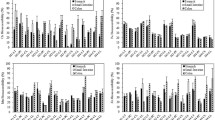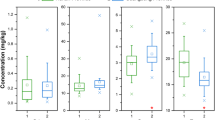Abstract
The study aims to seek the dietary strategies to reduce the bioaccessibility of Cd and As in contaminated rice. A total of 12 selected food matrices were assayed by using the in vitro gastrointestinal digestion models. The results showed that tomato, carrot, water spinach, and spinach reduced the solubility of Cd by 45–78%, 50–71%, 53–70%, and 45–71%, respectively. Meanwhile, tomato, carrot, potato, and sweet potato reduced the solubility of As by 53–79%, 50–80%, 40–71%, and 36–76% in aqueous solution, respectively. In both gastric and gastrointestinal phases, Cd and As bioaccessibility decreased as the amount (100, 200, or 400 mg) of food matrices increased (except for As in water spinach). These results suggested that the uses of some foodstuffs may be a good dietary strategy to reduce Cd and As bioaccessibility, although in vivo studies are required to confirm their suitability.




Similar content being viewed by others
References
Anetor JI (2012) Rising environmental cadmium levels in developing countries: threat to genome stability and health. Niger J Physiol Sci 27(2):103–115
ATSDR (2007) Toxicological profile for arsenic. Agency for Toxic Substances and Disease Registry, http://www.atsdr.cdc.gov/toxprofiles/tp2.pdf (accessed July 2017)
Codex Alimentarius Commission (CAC) (2017) Joint FAO/WHO general standards for contaminants and toxins in food and feed. (CXS 193-1995) Adopted in 1995. Revised in 1997, 2006, 2008, 2009. Amended in 2010, 2012, 2013, 2014, 2015, 2016, 2017
Clemente MJ, Devesa V, Vélez D (2016) Dietary strategies to reduce the bioaccessibility of arsenic from food matrices. J Agr Food Chem 64:923–931
Dewanjee S, Sahu R, Karmakar S, Gangopadhyay M (2013) Toxic effects of lead exposure in Wistar rats: involvement of oxidative stress and the beneficial role of edible jute (Corchorus olitorius) leaves. Food Chem Toxicol 55:78–91
De Moura CF, Ribeiro DA (2017) Are food compounds able to modulate noxious activities induced by cadmium exposure? Crit Rev Food Sci Nutrit 57(3):632–636
Haleagrahara N, Jackie T, Chakravarthi S, Rao M, Pasupathi T (2010) Protective effects of Etlingera elatior extract on lead acetate-induced changes in oxidative biomarkers in bone marrow of rats. Food Chem Toxicol 48:2688–2694
Horiuchi S, Tachibana Y, Yamashita M, Yamamoto K, Masai K, Takase K, Matsutani T, Kawamata S, Kurashige Y, Yanai T, Murahashi T (2015) Multinuclear metal-binding ability of a carotene. Nat Commun 6:6742
Huang M, Choi SJ, Kim DW, Kim NY, Park CH, Yu SD, Kim DS, Park KS, Song JS, Kim H, Choi BS, Yu IJ, Park JD (2009) Risk assessment of low-level cadmium and arsenic on the kidney. J Toxicol Environ Health A 72(21–22):1493–1498
Jadán C, Sánchez V, Vélez D, Devesa V (2016) Reduction of mercury bioaccessibility using dietary strategies. LWT-Food Sci Technol 7:10–16
Juhasz AL, Smith E, Weber J, Rees M, Rofe A, Kuchel T, Sansom L, Naidu R (2008) Application of an in vivo swine model for the determination of arsenic bioavailability in contaminated vegetables. Chemosphere 71:1963–1969
Meharg AA, Norton G, Deacon C, Williams P, Adomako EE, Price A, Zhu Y, Li G, Zhao FJ, McGrath S, Villada A, Sommella A, De Silva PM, Brammer H, Dasgupta T, Islam MR (2013) Variation in rice cadmium related to human exposure. Environ Sci Technol 47:5613–5618
MHPRC (Ministry of Health of the People’s Republic of China) (2017) The limits of pollutants in foods (GB 2762–2017) (in Chinese). MHPRC, Beijing
Mitchell (2014) Health risks associated with chronic exposures to arsenic in the environment. Rev Mineral Geochem 79:435–449
Mitra E, Ghosh AK, Ghosh D, Mukherjee D, Chattopadhyay A, Dutta S, Pattari SK, Bandyopadhyay D (2012) Protective effect of aqueous curry leaf (Murraya koenigii) extract against cadmium-induced oxidative stress in rat heart. Food Chem Toxicol 50:1340–1353
Nwokocha CR, Nwokocha MI, Aneto I, Ob J, Udekweleze DC, Olatunde B, Owu DU, Iwuala MO (2012) Comparative analysis on the effect of Lycopersicon esculentum (tomato) in reducing cadmium, mercury and lead accumulation in liver. Food Chem Toxicol 50:2070–2073
Oomen AG, Hack A, Minekus M, Zeijdner E, Cornelis C, Schoeters G, Verstraete W, Van de Wiele T, Wragg J, Rompelberg CJ, Sips AJ, Van Wijnen JH (2002) Comparison of five in vitro digestion models to study the bioaccessibility of soil contaminants. Environ Sci Technol 36:3326–3334
Ouédraogo O, MarcAmyot M (2011) Effects of various cooking methods and food components on bioaccessibility of mercury from fish. Environ Res 111:1064–1069
Renugadevi J, Prabu SM (2010) Cadmium-induced hepatotoxicity in rats and the protective effect of naringenin. Exp Toxicol Pathol 62(2):171–181
Salawu EO, Adeleke AA, Oyewo OO, Ashamu EA, Ishola OO, Afolabi AO (2009) Prevention of renal toxicity from lead exposure by oral administration of Lycopersicon esculentum. J Toxicol Environ Health Sci 1:22–27
Satarug S, Vesey DA, Gobe GC (2017) Health risk assessment of dietary cadmium intake: do current guidelines indicate how much is safe? Environ Health Perspect 125:284–288
Sears ME (2013) Chelation: harnessing and enhancing heavy metal detoxification—a review. Sci World J 2013:219840
Shim SM, Ferruzzi MG, Kim YC, Janle EM, Santerre CR (2009) Impact of phytochemical-rich foods on bioaccessibility of mercury from fish. Food Chem 112:46–50
Steffens J, Hunt D, Williams B (1986) Accumulation of non-protein metal-binding polypeptides (gamma-glutamyl-cysteinyl) n-glycine in selected cadmium-resistant tomato cells. J Biol Chem 261:13879–13882
USEPA (2010) Integrated risk information system-database. Philadelphia PA; Washington, DC
Wang KS, Huang LC, Lee HS, Chen PY, Chang SH (2008) Phytoextraction of cadmium by Ipomoea aquatic (water spinach) in hydroponic solution: effects of cadmium speciation. Chemosphere 72(4):666–672
Wragg J, Cave M, Basta N, Brandon E, Casteel S, Denys S, Gron C, Oomen A, Reimer K, Tack K, Van de Wiele T (2011) An inter-laboratory trial of the unified BARGE bioaccessibility method for arsenic, cadmium and lead in soil. Sci Total Environ 409:4016–4030
Yang UJ, Yoon SR, Chung JH, Kim YJ, Park KH, Park TS, Shim SM (2012) Water spinach (Ipomoea aquatic Forsk.) reduced the absorption of heavy metals in an in vitro bio-mimicking model system. Food Chem Toxicol 50:3862–3866
Yu HY, Liu S, Li M, Wu B (2016) Influence of diet, vitamin, tea, trace elements and exogenous antioxidants on arsenic metabolism and toxicity. Environ Geochem Health 38:339–351
Zhai QX, Narbad A, Chen W (2015) Dietary strategies for the treatment of cadmium and lead toxicity. Nutrients 7:552–571
Zhuang P, McBride MB, Xia HP, Li NY, Li ZA (2009) Health risk from heavy metals via consumption of food crops in the vicinity of Dabaoshan mine, South China. Sci Total Environ 407:1551–1561
Zhuang P, Li YW, Zou B, Su F, Zhang CS, Mo H, Li ZA (2016a) Oral bioaccessibility and human exposure of cadmium and lead from market vegetables in Pearl River Delta, South China. Environ Sci Pollut Res 23(23):24402–24410
Zhuang P, Zhang CS, Li YW, Zou B, Mo H, Wu KJ, Li ZA (2016b) Assessment of influences of cooking on cadmium and arsenic bioaccessibility in rice, using an in vitro physiologically-based extraction test. Food Chem 213:206–214
Funding
This research work was financially supported by the Key project of Science and Technology Program of Guangzhou (No. 201803030035), the National Natural Science Foundation of China (Nos. 41301571 and 31670513), the R & D program of Guangdong Provincial Department of Science and Technology (No. 2016A020221023), and the National Key Technologies R&D Program of China (2015BAD05B05).
Author information
Authors and Affiliations
Corresponding authors
Ethics declarations
Conflict of interest
The authors declare that they have no conflict of interest.
Additional information
Responsible editor: Philippe Garrigues
Rights and permissions
About this article
Cite this article
Zhuang, P., Sun, S., Su, F. et al. Dietary strategies to reduce the oral bioaccessibility of cadmium and arsenic in rice. Environ Sci Pollut Res 25, 33353–33360 (2018). https://doi.org/10.1007/s11356-018-3237-y
Received:
Accepted:
Published:
Issue Date:
DOI: https://doi.org/10.1007/s11356-018-3237-y




